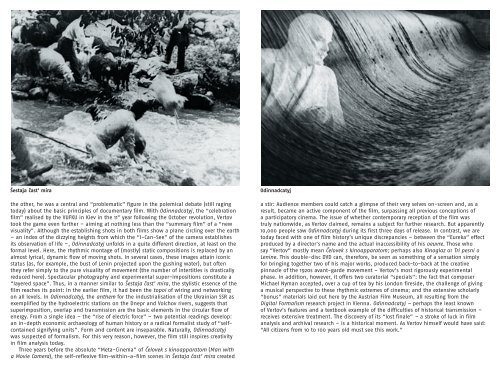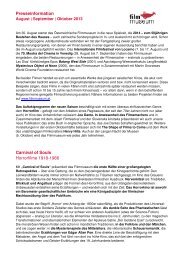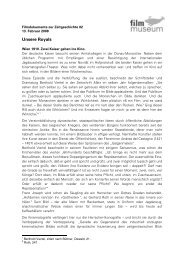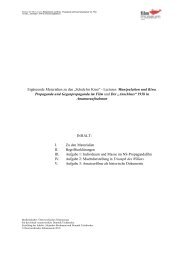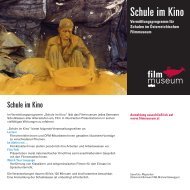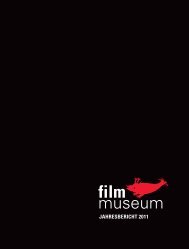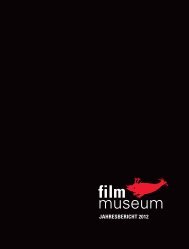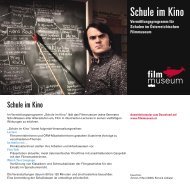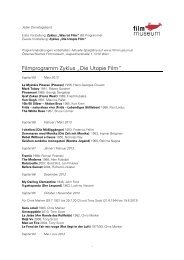Booklet - Österreichisches Filmmuseum
Booklet - Österreichisches Filmmuseum
Booklet - Österreichisches Filmmuseum
Erfolgreiche ePaper selbst erstellen
Machen Sie aus Ihren PDF Publikationen ein blätterbares Flipbook mit unserer einzigartigen Google optimierten e-Paper Software.
53 VertovSestaja_booklet:ef 14.12.2009 11:42 Uhr Seite 10<br />
Šestaja čast’ mira Odinnadcatyj<br />
the other, he was a central and “problematic” figure in the polemical debate (still raging<br />
today) about the basic principles of documentary film. With Odinnadcatyj, the “celebration<br />
film” realised by the VUFKU in Kiev in the 11 th year following the October revolution, Vertov<br />
took the game even further – aiming at nothing less than the “summary film” of a “new<br />
visuality”. Although the establishing shots in both films show a plane circling over the earth<br />
– an index of the dizzying heights from which the “I-Can-See” of the camera establishes<br />
its observation of life –, Odinnadcatyj unfolds in a quite different direction, at least on the<br />
formal level. Here, the rhythmic montage of (mostly) static compositions is replaced by an<br />
almost lyrical, dynamic flow of moving shots. In several cases, these images attain iconic<br />
status (as, for example, the bust of Lenin projected upon the gushing water), but often<br />
they refer simply to the pure visuality of movement (the number of intertitles is drastically<br />
reduced here). Spectacular photography and experimental super-impositions constitute a<br />
“layered space”. Thus, in a manner similar to Šestaja čast’ mira, the stylistic essence of the<br />
film reaches its point: In the earlier film, it had been the topoi of wiring and networking<br />
on all levels. In Odinnadcatyj, the anthem for the industrialisation of the Ukrainian SSR as<br />
exemplified by the hydroelectric stations on the Dnepr and Volchov rivers, suggests that<br />
superimposition, overlap and transmission are the basic elements in the circular flow of<br />
energy. From a single idea – the “rise of electric force” – two potential readings develop:<br />
an in-depth economic archaeology of human history or a radical formalist study of “selfcontained<br />
signifying units”. Form and content are inseparable. Naturally, Odinnadcatyj<br />
was suspected of formalism. For this very reason, however, the film still inspires creativity<br />
in film analysis today.<br />
Three years before the absolute “Meta-Cinema” of Čelovek s kinoapparatom (Man with<br />
a Movie Camera), the self-reflexive film-within-a-film scenes in Šestaja čast’ mira created<br />
a stir: Audience members could catch a glimpse of their very selves on-screen and, as a<br />
result, became an active component of the film, surpassing all previous conceptions of<br />
a participatory cinema. The issue of whether contemporary reception of the film was<br />
truly nationwide, as Vertov claimed, remains a subject for further research. But apparently<br />
10,000 people saw Odinnadcatyj during its first three days of release. In contrast, we are<br />
today faced with one of film history’s unique discrepancies – between the “Eureka” effect<br />
produced by a director’s name and the actual inaccessibility of his oeuvre. Those who<br />
say “Vertov” mostly mean Čelovek s kinoapparatom; perhaps also Kinoglaz or Tri pesni o<br />
Lenine. This double-disc DVD can, therefore, be seen as something of a sensation simply<br />
for bringing together two of his major works, produced back-to-back at the creative<br />
pinnacle of the 1920s avant-garde movement – Vertov’s most rigorously experimental<br />
phase. In addition, however, it offers two curatorial “specials”: the fact that composer<br />
Michael Nyman accepted, over a cup of tea by his London fireside, the challenge of giving<br />
a musical perspective to these rhythmic extremes of cinema; and the extensive scholarly<br />
“bonus” materials laid out here by the Austrian Film Museum, all resulting from the<br />
Digital Formalism research project in Vienna. Odinnadcatyj – perhaps the least known<br />
of Vertov’s features and a textbook example of the difficulties of historical transmission –<br />
receives extensive treatment. The discovery of its “lost finale” – a stroke of luck in film<br />
analysis and archival research – is a historical moment. As Vertov himself would have said:<br />
“All citizens from 10 to 100 years old must see this work.”


